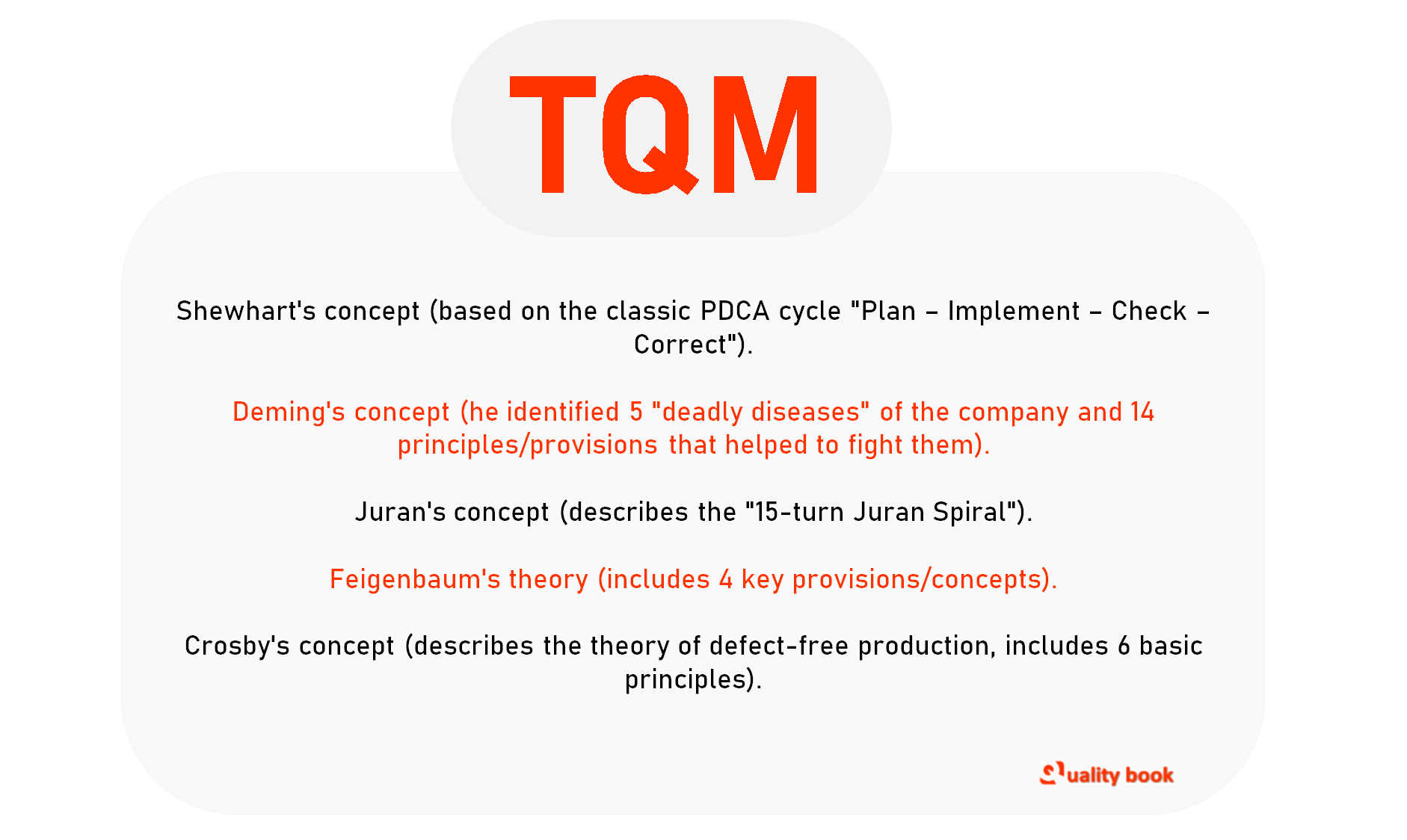The way to organize the implementation of TQM involves the creation of:
- a coordinating group for the implementation of TQM, performing the same functions as QSG.
- Corrective action teams (CAT), which manage processes, analyzing them and making changes to them; CAT are created on a temporary basis by the coordinating group for the implementation of TQM and receive their tasks from it.
- Process improvement teams (PIT), which are engaged in the systematic improvement of processes and the preservation of improved processes using TQM methods. Once CAT makes the process manageable, its performance will be continuously improved and maintained by PIT members so that CAT results are not lost over time. PIT is formed by the managing unit (department) and receives tasks from it.

The corrective action team consists of 5-8 employees, such as performers and operators, who are constantly involved in this particular process in their daily work. Usually, the team also includes a representative of one of the support units, say, a specialist in repair and maintenance or quality control.
The head of CAT, as a rule, is an employee of the interested department. CAT performs the following critical tasks:
- Mapping and process description.
- Analysis of the process and measurements, determination of the causes and consequences of errors, ranking of errors by their significance.
- Development of improvement measures.
- Taking measures to ensure the manageability of the process.
- Adjustment of working methods.
- Purchase or manufacture of devices for work.
- Providing written reports to the coordinating team.
Team Coordination
The corrective action team receives the task from the TQM coordinating group. It indicates the desire result (goal), the timing of its achievement, the frequency of reporting to the coordinating team, as well as what is expect from each team member.
After completing the task, the coordinating team disbands the CAT, having previously reviewed the results of its work, and determined the amount of its final remuneration. The coordination team (with the participation of an experienced auditor) usually draws a line under this phase, checking the results obtained and certifying the process.
The purpose of this is to make sure that CAT has been able to implement TQM in its workplace and that a managed process actually exists. If these conditions are met, the CAT receives a certificate that is valid for one year. After this period, the process must be certified again.
This does not mean that CAT members’ work ends, and they can rest. Once CAT makes the process manageable, it must be continuously improve and maintain to ensure that the results obtain will be lost over time. For this purpose, a Process Improvement Team (PIT) is created, into which CAT is converted.
PIT & CAT
The composition of PIT corresponds to the composition of CAT. Ultimately, PIT and CAT may be run by the same people. In this case, the team also includes employees who are directly related to the process in their daily work, and employees of other departments; all of them meet regularly on set days in a certain place. Likewise, like CAT, PIT has a chairman and secretary. PIT members are not appoint by the TQM implementation coordinating team, but by the managing unit. From him PIT receives its tasks. In this case, the role of the coordinating group is perform by the manager. The goal of creating a PIT is considering to have been achieve if, as the facts show, improvement measures are implementing continuously.
Pit’s tasks include, but are not limited to:
- Recording, organizing, and counting (using a checklist) in a special log of all failures during the process.
- Process analysis and measurements.
- Determining the significance of each process failure (using the FMEA method) and documenting the implemented improvement measures.
- Implementation of improvement measures, as well as increasing safety, cleanliness in the workplace, improving ergonomics, reducing waste, etc .
- Adjustment of working methods.
- Continuous documentation of the improvement process.
- Preparation of written reports for all unit managers (at least once every two weeks).
Among the most important tasks of the managerial unit are:
- Documentation of goals and related strategies.
- Definition of stages of work, intermediate results, and time planning.
- PIT formation.
- Setting tasks for PIT.
- Measuring PIT progress.
- Initiation of training.
- Creation of conditions for optimal functioning of PIT.
- Management and coordination of PIT activities.
The tasks of PIT and the unit manager are consistent with the PDCA cycle. This means that PIT does not dissolve, although its composition may change over time.
TQM & SPC
The PIT organization is of particular importance for the introduction of statistical process control (SPC). SPC assumes that certain evaluation tools (tools and methods) of evaluation (factors and results) are use to achieve and maintain the manageability of the process.
Such tools are:
- A flowchart of the process, in which what is actually complete is represent by conventional symbols.
- Data collection checklists.
- Distribution histograms for data presentation.
- A Pareto diagram that separates “a few significant factors” from “numerous mediocre”.
- Analysis of cause-and-effect dependencies and “brainstorming”, which help to push the boundaries of thinking and solve the problem.
- Scatter charts to identify possible relationships between factors.
- Control charts that give a picture of fluctuations in time.
The basic rules of the SPC are as follows.
- No process without data. (The analysis of any process begins with the collection of data.)
- No data without analysis. (It will be good if all the data are analyse.)
- No analysis without a solution. (Any analysis should lead to a decision.)
The successful application of TQM requires an integrated and design-oriented approach and the strenuous efforts of all involved. Unfortunately, many TQM implementation projects have not been implement fully, or properly.